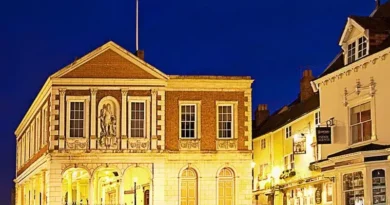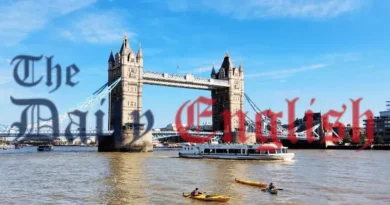25 Best Historical Places to Visit in the UK
The United Kingdom is steeped in history, with landmarks and sites that tell the story of the nation’s rich and varied past. The UK offers a fascinating journey through time, from ancient Roman fortifications to medieval castles and modern wartime bunkers. This article explores 25 historic places you must visit to appreciate the depth of British history truly.
1. Hadrian’s Wall

Hadrian’s Wall, stretching across Northern England, is a UNESCO World Heritage site that marks the northern boundary of the Roman Empire in Britain. Built around AD 122 under the orders of Emperor Hadrian, this impressive fortification was designed to keep out the Picts from Scotland. The Wall runs for 73 miles from the banks of the River Tyne near the North Sea to the Solway Firth on the Irish Sea.
Visitors can walk along parts of the Wall, explore the ruins of forts such as Housesteads and Vindolanda, and learn about Roman military life in the numerous museums dotted along its length.
The Wall is not just a defensive structure but a testament to the engineering prowess of the Romans.
2. North Cornwall’s Museum of Witchcraft and Magic
Located in the quaint village of Boscastle, the Museum of Witchcraft and Magic houses the world’s largest collection of artefacts related to witchcraft, magic, and the occult. Established in 1951, the museum delves into the history of witchcraft in Britain, exploring how it has been perceived and practised over the centuries. The collection includes everything from ancient spell books and amulets to tools used in witchcraft practices.
The museum offers a unique and fascinating look at a subject often shrouded in mystery and misunderstanding, making it a must-visit for those interested in the darker aspects of British history.
3. Titanic Belfast, Northern Ireland

Titanic Belfast is a modern museum in the Harland & Wolff shipyard where the RMS Titanic was built. The museum offers a comprehensive and interactive experience that traces the ship’s construction, launch, and tragic maiden voyage in 1912. The building is designed to resemble the ship’s hulls and is a poignant reminder of the lost lives.
Inside, visitors can explore nine interactive galleries that bring the Titanic’s story to life, from its conception and construction to its ill-fated journey and the aftermath of the disaster.
This site is a memorial to a tragic event and a celebration of Belfast’s rich industrial heritage.
4. Warwick Castle, Warwickshire

Warwick Castle was originally built in 1068 by William the Conqueror after his Norman invasion of England. Initially, it was a wooden motte-and-bailey structure, but it was later rebuilt in stone during the 12th & 13th centuries. In the 14th century, further fortifications were added, particularly to protect against potential threats during the Hundred Years’ War. The castle played a significant defensive role in English history until the early 17th century. In 1604, King James I granted it to Sir Fulke Greville, who transformed it into a stately home. The Greville family owned the castle until 1978, and today, it is a popular tourist attraction with historical reenactments like jousting and a maze inspired by Horrible Histories.
The grounds and architecture offer visitors insight into medieval life.
5. Bletchley Park, Buckinghamshire

Bletchley Park, located in Buckinghamshire, was a secret centre of British codebreaking during World War II. Among the codebreakers was Alan Turing, whose work on breaking the Enigma cypher contributed significantly to the Allied war effort. Historians agree that the intelligence gathered at Bletchley Park significantly contributed to the success of the Allied war effort, and many believe it helped shorten the conflict.
Today, Bletchley Park is a museum that preserves the original codebreaking huts and equipment, with exhibitions detailing the vital work during the war.
6. Roman Baths, Somerset

The Roman Baths in Bath are one of Britain’s best-preserved examples of Roman architecture. The Roman Baths complex began construction after the Romans founded the city of Aquae Sulis (modern-day Bath) around 44 AD, with the main bathhouse likely completed by 70 AD. These baths were built over a natural hot spring, revered by local Celtic tribes before the Roman arrival. The site includes the Sacred Spring, the Roman Temple, and the bathhouse, all remarkably preserved.
Visitors can explore the museum, which contains Roman artefacts like coins and jewellery found on-site. While the water is no longer used for bathing due to its high lead content, the Roman Baths remain a symbol of Roman engineering and cultural influence.
7. Edinburgh Castle, Scotland

Edinburgh Castle is a historic fortress located atop Castle Rock, a volcanic formation in the centre of Edinburgh. Archaeological evidence suggests Castle Rock has been occupied since the Iron Age. Still, the castle’s current form began to take shape in the 12th century. It played a key role in Scottish history, particularly during the Wars of Scottish Independence and the Lang Siege of the 16th century.
Today, visitors can view the Honours of Scotland (the Scottish Crown Jewels) and the Stone of Destiny, used in the coronation of Scottish and British monarchs. The castle also houses the National War Museum of Scotland, offering insights into the country’s military past.
8. Stonehenge, Wiltshire

Stonehenge is a prehistoric monument located on Salisbury Plain in Wiltshire. Composed of large standing stones arranged in a circular layout, Stonehenge’s major stone settings date to around 2500 BC, though the earliest monument, a circular ditch, dates to around 3000 BC. The construction of the stone settings occurred in stages. While its exact purpose remains uncertain, some theories suggest it may have been used as a burial site or for ceremonial and astronomical purposes. The stones were transported from distances as far as Wales, demonstrating remarkable engineering skills for the time.
Visitors can walk around the monument and explore the visitor centre, which offers exhibits on the site’s archaeological significance.
9. Kidwelly Castle, West Wales

Kidwelly Castle in Carmarthenshire is a well-preserved example of Norman military architecture. Established around 1106 by Roger, Bishop of Salisbury, the castle was expanded over the centuries, playing a key role in the conflicts between Welsh princes and Norman lords. Its strategic location made it a valuable defensive structure, especially during conflicts between Welsh princes and Norman lords, including later Welsh uprisings such as the rebellion of Owain Glyndŵr.
Today, visitors can explore its ruins, including the gatehouse, towers, and curtain walls, and enjoy views of the surrounding landscape.
10. Osborne House, Isle of Wight

Osborne House, designed by Prince Albert in the Italianate style, was the seaside retreat of Queen Victoria and Prince Albert. The house became a private sanctuary for the royal family, where they could escape the public eye. Queen Victoria spent much of her later life at Osborne House, and it was there that she passed away in 1901.
The house, now open to the public, includes many personal artefacts and provides insight into the private lives of the royal family. The estate also features the Swiss Cottage, where the royal children were educated in gardening and household management.
11. Canterbury Cathedral, Kent

Canterbury Cathedral is one of England’s most significant Christian sites, dating to its foundation by St. Augustine in 597 AD. It has been a pilgrimage destination since the martyrdom of Archbishop Thomas Becket in 1170, an event that deeply influenced English history.
After a devastating fire in 1174, Canterbury Cathedral was rebuilt primarily in Gothic, marking a significant architectural transformation. The reconstruction introduced intricate ribbed vaulting, pointed arches, and stunning stained glass windows, some of which remain as rare medieval examples. While the Cathedral’s Bell Harry Tower is its most notable vertical feature, its overall design blends elements from its earlier Norman structure and later Gothic additions.
Canterbury Cathedral remains a functioning place of worship and a UNESCO World Heritage Site, symbolizing its global religious and cultural significance.
12. HMS Belfast, London

Launched in 1938, HMS Belfast is a World War II warship now moored on the River Thames. It was vital in key military campaigns, such as the Arctic convoys and the D-Day landings. After decommissioning in 1963, it was preserved as a museum, offering visitors an immersive look into naval life. Its nine decks include original gun turrets, engine rooms, and crew quarters, providing a vivid experience of the ship’s wartime history.
13. Fountains Abbey, North Yorkshire

Fountains Abbey is one of England’s largest and most significant Cistercian monastery ruins. Established in 1132, it flourished until its dissolution under Henry VIII in 1539. The ruins, now part of the Studley Royal Water Garden and a UNESCO World Heritage Site, showcase the grandeur of medieval monastic life.
Visitors can explore its vast remains, including the cloisters, church, and surrounding landscaped gardens.
14. Stirling Castle, Scotland

Perched on a volcanic rock, Stirling Castle is one of Scotland’s most important historical sites. It played a pivotal role during the Wars of Scottish Independence. It witnessed key events such as the coronation of Mary, Queen of Scots. Its restored Renaissance interiors and panoramic views offer visitors a glimpse into Scotland’s royal and military past.
15. Tower of London, London

Founded in 1066 by William the Conqueror, the Tower of London has served as a fortress, royal palace, prison, and treasury. It houses the Crown Jewels and has been the site of many significant historical events, including the imprisonment of high-profile figures like Anne Boleyn.
Today, the Tower remains a top tourist attraction, with guided tours by the Yeoman Warders.
16. Hampton Court Palace, Surrey

Hampton Court Palace, situated on the River Thames, was originally built by Cardinal Wolsey in 1514 as a luxurious residence. Still, after his fall from grace, King Henry VIII took it over and expanded it significantly. The palace is famous for its Tudor architecture and association with Henry and his six wives. The iconic Great Hall at Hampton Court Palace features a hammer-beam roof. It hosted many theatrical and courtly events.
Today, visitors can explore the state apartments, the Great Watching Chamber, and the elaborate gardens, including the famous maze and astronomical clock. Notably, the palace’s kitchens were some of the largest in Tudor times, designed to cater to hundreds daily.
Hampton Court remains a testament to Tudor and Baroque architectural styles and historical significance.
17. Crumlin Road Prison, Belfast

Crumlin Road Prison, commonly known as “The Crum,” opened in 1846 and operated for over 150 years before closing in 1996. It was notorious for housing various prisoners, including those involved in the Troubles. The prison was the site of several executions, and its design was based on the Victorian “separate system” aimed at reforming inmates.
Today, it is a museum offering guided tours, which include viewing the execution chamber, tunnels to the courthouse, and the infamous holding cells. The prison’s history is deeply intertwined with the political conflicts of Northern Ireland.
18. Westminster Abbey, London

Westminster Abbey, a UNESCO World Heritage Site, has been one of England’s most important religious and historical buildings since the 11th century. Founded as a Benedictine monastery in 960 AD, it has been the coronation church for British monarchs since 1066. It is also the final resting place for numerous historical figures, including Charles Darwin, Isaac Newton, and Geoffrey Chaucer. The Abbey’s architecture is primarily Gothic, with towering vaulted ceilings, ornate stonework, and stunning stained-glass windows.
Visitors can explore its chapels, the Coronation Chair, and the Poets’ Corner, where many of Britain’s greatest literary figures are commemorated.
19. Blenheim Palace, Oxfordshire

Blenheim Palace is one of the grandest stately homes in England and a UNESCO World Heritage Site. It was built between 1705 and 1722 as a gift to John Churchill, 1st Duke of Marlborough, for his victory at the Battle of Blenheim. It is a prime example of English Baroque architecture and is also famous for being the birthplace of Winston Churchill in 1874.
The palace features magnificent state rooms filled with art and historical artefacts, and its gardens were designed by the famous landscape architect Capability Brown. The estate’s history, art, and connection to the Churchill family make it a must-see.
20. Dover Castle and Tunnels, Kent

Dover Castle, often called the “Key to England,” has been a vital defensive fortress since it was first built by William the Conqueror in the 11th century. Over the centuries, it has played a key role in various historical events, including the Napoleonic Wars and World War II.
One of the most fascinating aspects of Dover Castle is its extensive underground tunnel network, which was expanded during WWII and served as a command centre for the evacuation of Dunkirk in 1940, known as Operation Dynamo.
Visitors can explore the medieval keep, the Great Tower, and the wartime tunnels, offering panoramic views of the English Channel.
21. St. Michael’s Mount, Cornwall

St. Michael’s Mount is a tidal island off the coast of Cornwall with a history tied to both legend and the religious traditions of Mont Saint-Michel in Normandy. It is topped by a medieval castle and chapel, home to the St Aubyn family since the 17th century.
Visitors can access the island on foot via the causeway during low tide or by boat at high tide, exploring the sub-tropical gardens, the medieval chapel, and the castle’s historic interiors. The island is steeped in folklore, including legends of giants and miraculous events.
22. King Richard III Visitor Centre and Leicester Cathedral
The King Richard III Visitor Centre in Leicester tells the dramatic story of Richard III, the last Plantagenet king, whose remains were rediscovered in 2012 under a city car park. The Visitor Centre highlights his life, death at the Battle of Bosworth, and the meticulous archaeological discovery that confirmed his identity through DNA testing. Nearby, Leicester Cathedral houses Richard III’s tomb, where his remains were reinterred in 2015. The tomb is crafted from Swaledale fossil limestone, adding dignity to the final resting place of one of England’s most debated monarchs.

23. Arbroath Abbey, Scotland

Arbroath Abbey is historically significant as the site where the Declaration of Arbroath was signed in 1320, declaring Scotland’s independence from England. Founded in 1178 by King William the Lion, the Abbey’s majestic ruins attract those interested in Scotland’s history, with its red sandstone walls evoking the medieval power of Scotland.
Visitors can explore the remains of the abbey church, cloisters, and chapter house.
24. Churchill War Rooms, London

The Churchill War Rooms in Westminster offer a glimpse into the underground bunkers where Winston Churchill and his team directed Britain’s military efforts during World War II. Visitors can explore the Churchill War Rooms, including the Map Room, Cabinet Room, and other historically significant areas, which have been carefully restored to reflect their wartime appearance.
While the rooms were preserved largely as they were left at the end of World War II, some areas have undergone restoration to maintain their integrity. The adjacent museum offers a detailed exploration of Churchill’s leadership and the broader context of the war, enhancing the educational experience for visitors.
25. Windsor Castle, Berkshire

Windsor Castle, the world’s oldest inhabited castle, has been a royal residence for over 1,000 years. Built by William the Conqueror, the castle showcases evolving architecture and remains an official residence of the British monarchy. Visitors can tour the State Apartments, home to numerous royal treasures, and explore St. George’s Chapel, the burial place of monarchs like Henry VIII and Queen Elizabeth II.
These sites showcase the rich and varied history of the UK, from medieval abbeys to royal fortresses, and provide insights into significant events that shaped the British Isles.










Comments are closed.